| Srl | Item |
| 1 |
ID:
114985
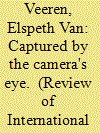

|
|
|
|
|
| Publication |
2011.
|
| Summary/Abstract |
In January 2002, images of the detention of prisoners held at US Naval Station Guantanamo Bay as part of the Global War on Terrorism were released by the US Department of Defense, a public relations move that Secretary of Defense Donald Rumsfeld later referred to as 'probably unfortunate'. These images, widely reproduced in the media, quickly came to symbolise the facility and the practices at work there. Nine years on, the images of orange-clad 'detainees' - the 'orange series' - remain a powerful symbol of US military practices and play a significant role in the resistance to the site. However, as the site has evolved, so too has its visual representation. Official images of these new facilities not only document this evolution but work to constitute, through a careful (re)framing (literal and figurative), a new (re)presentation of the site, and therefore the identities of those involved. The new series of images not only (re)inscribes the identities of detainees as dangerous but, more importantly, work to constitute the US State as humane and modern. These images are part of a broader effort by the US administration to resituate its image, and remind us, as IR scholars, to look at the diverse set of practices (beyond simply spoken language) to understand the complexity of international politics.
|
|
|
|
|
|
|
|
|
|
|
|
|
|
|
|
| 2 |
ID:
097718
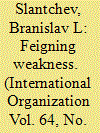

|
|
|
|
|
| Publication |
2010.
|
| Summary/Abstract |
In typical crisis bargaining models, strong actors must convince the opponent that they are not bluffing and the only way to do so is through costly signaling. However, in a war, strong actors can benefit from tactical surprise when their opponent mistakenly believes that they are weak. This creates contradictory incentives during the pre-war crisis: actors want to persuade the opponent of their strength to gain a better deal but, should war break out, they would rather have the opponent believe they are weak. I present an ultimatum crisis bargaining model that incorporates this dilemma and show that a strong actor may feign weakness during the bargaining phase. This implies that (1) absence of a costly signal is not an unambiguous revelation of weakness, (2) the problem of uncertainty is worse because the only actor with incentives to overcome it may be unwilling to do so, and (3) because of the difficulty with concealing resolve, democracies might be seriously disadvantaged in a crisis.
|
|
|
|
|
|
|
|
|
|
|
|
|
|
|
|
| 3 |
ID:
142346
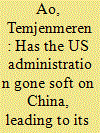

|
|
|
| 4 |
ID:
141598
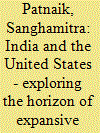

|
|
|
|
|
| Summary/Abstract |
The Indo- US relations represent a new landmark in the changed international scenario. They are the proud fore- runners of the two most populous democracies of the world. The determined effort of the US administration to assist in India’s rise as a major power has significant implications for US interests in Asia in general and South Asia in particular. The collapse of the Soviet Union had changed the balance of power. Every country including India is looking for an appropriate place in this changed scenario. The Indo – US partnership that had made a new beginning during the latter part of the Clinton Administration that reached a new high to build up new security architecture in Asia. The 2005 US-India agreement showed their resolve to establish a “global partnership” through increased cooperation on various issues. It is interesting to analyze the dynamics of Indo-US relations under a new government led by the Indian Prime Minister Narendra Modi.
|
|
|
|
|
|
|
|
|
|
|
|
|
|
|
|
| 5 |
ID:
124835
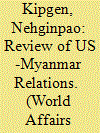

|
|
|
|
|
| Publication |
2013.
|
| Summary/Abstract |
The release of political prisoners by the Burmese government and the successful holding of by-elections were two major landmarks of 2012 that led to improvements in relations between US and Myanmar. The confirmation of Derek Mitchell as the new US Ambassador to Myanmar an the lifting of American investment sanctions followed by the suspension of import bans from the country were significant results of the improving relationship.
|
|
|
|
|
|
|
|
|
|
|
|
|
|
|
|